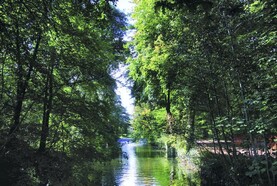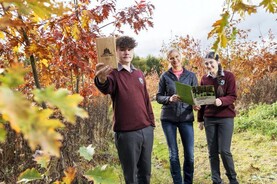Most private forest owners in Ireland have yet to face up to the challenges of reforestation as almost 90% of private grant-aided forests are aged 30 years or less, according to Forest Statistics Ireland 2024.
There are a number of obvious differences between afforestation and reforestation, not least cost. The cost of reforestation is borne by forest owners as there are no State grants or premium payments available, while there is a requirement to reduce the commercial component by at least 20% especially on sites where setback from roads and rivers is required.
Most owners of commercial forest will have planned for the allocation of clearfell revenue towards the cost of reforestation. It is also probable that they will wish to maximise the value of the reforested crop by staying with the species mix of the first crop which is generally Sitka spruce, although broadleaf afforestation has increased to 40% of total planting in recent years.
Some forest owners may wish to change both the crop structure and species on reforested sites and so opt for a more species diverse future forest.
Up to now, this wasn’t an option as diversity – especially native species diversity – is costly at forest establishment, while the potential future revenue stream won’t be available for generations to come or, in some instances, will be non-existent.
The Department has now decided to incentivise forest owners who wish to take a different approach when reforesting their harvested sites. Three new schemes (Table 1) qualify for an establishment grant, which covers some or most of the reforestation costs and an annual eco-system payment is available for seven years.
Climate resilient reforestation
This will part compensate the forest owner for creating a more diverse but less commercially attractive crop on reforested sites. Essentially, these are supports that encourage ‘climate-resilient reforestation’ including greater tree species diversity.
The new pilot schemes are divided into the following three reforestation elements:
Continuous cover forestry (CCF).Native Woodlands.Biodiversity and water.Continuous cover forestry
The CCF reforestation scheme promotes mixed species, but allows for a commercial return as early as 15 years like clearfell rotation crops, as conifers can still be the main major species. However, diversification of tree species – broadleaves and conifers – is a major objective in CCF.
In recent times, almost all CCF projects have been carried out in existing forests. In these cases, the forest owner and forester have transformed the forest from a normal rotation – thinning and eventual clearfell – to a permanent continuous forest as the name CCF implies.
However, CCF transformation is reliant on the age of the forest.
Fast-growing coniferous forests cannot make the transition to CCF as they reach maturity – the cutoff point is around age 15 or possibly up to year 20 on sheltered wind stable sites.
Once forests pass this threshold, they need to run to full rotation of 30 years or more and the forest owners can establish a new CCF on the clearfelled site. The challenges and opportunity are similar to the CCF afforestation forest type (FT 10) which Olive Leavy outlines in page 57.
While the CCF reforestation option is commercially attractive from a forest revenue perspective, the State financial incentives are lower than the other two schemes.
The CCF scheme provides a grant of €1,000/ha, which will cover approximately 30% of the establishment cost and an annual premium of €150/ha over seven years.
Native woodlands
The native woodland element is divided into two schemes: high ecological priority sites and all other sites. The grant aid provided for high ecological priority sites is €4,000/ha, while an annual ecosystem premium payment of €650/ha is paid out for seven years. All other sites qualify for a grant of €2,225/ha and an annual €500/ha seven-year premium payment.
What constitutes an ecological priority site is defined in the Department’s Forestry Standards Manual, which lists the various sites in Appendix 2 – Native Forest Framework.
The native woodland element will allow silvicultural practices such as thinning and tending.
While eventual timber production is permitted, this is a long-term multi-generational conservation scheme.
The third reforestation element is designed to create undisturbed areas for biodiversity and water protection. It involves drain-blocking, creation of filter ponds and slow-water damming. Trees can be planted at wide spacing in setback areas along rivers and streams. Natural regeneration is encouraged but the aim is to create a permanent semi-natural zone that will provide protection to water. As no harvesting activity or soil disturbance will take place in these sites, this scheme is ideal in freshwater pearl mussel catchment sites.
Most private forest owners in Ireland have yet to face up to the challenges of reforestation as almost 90% of private grant-aided forests are aged 30 years or less, according to Forest Statistics Ireland 2024.
There are a number of obvious differences between afforestation and reforestation, not least cost. The cost of reforestation is borne by forest owners as there are no State grants or premium payments available, while there is a requirement to reduce the commercial component by at least 20% especially on sites where setback from roads and rivers is required.
Most owners of commercial forest will have planned for the allocation of clearfell revenue towards the cost of reforestation. It is also probable that they will wish to maximise the value of the reforested crop by staying with the species mix of the first crop which is generally Sitka spruce, although broadleaf afforestation has increased to 40% of total planting in recent years.
Some forest owners may wish to change both the crop structure and species on reforested sites and so opt for a more species diverse future forest.
Up to now, this wasn’t an option as diversity – especially native species diversity – is costly at forest establishment, while the potential future revenue stream won’t be available for generations to come or, in some instances, will be non-existent.
The Department has now decided to incentivise forest owners who wish to take a different approach when reforesting their harvested sites. Three new schemes (Table 1) qualify for an establishment grant, which covers some or most of the reforestation costs and an annual eco-system payment is available for seven years.
Climate resilient reforestation
This will part compensate the forest owner for creating a more diverse but less commercially attractive crop on reforested sites. Essentially, these are supports that encourage ‘climate-resilient reforestation’ including greater tree species diversity.
The new pilot schemes are divided into the following three reforestation elements:
Continuous cover forestry (CCF).Native Woodlands.Biodiversity and water.Continuous cover forestry
The CCF reforestation scheme promotes mixed species, but allows for a commercial return as early as 15 years like clearfell rotation crops, as conifers can still be the main major species. However, diversification of tree species – broadleaves and conifers – is a major objective in CCF.
In recent times, almost all CCF projects have been carried out in existing forests. In these cases, the forest owner and forester have transformed the forest from a normal rotation – thinning and eventual clearfell – to a permanent continuous forest as the name CCF implies.
However, CCF transformation is reliant on the age of the forest.
Fast-growing coniferous forests cannot make the transition to CCF as they reach maturity – the cutoff point is around age 15 or possibly up to year 20 on sheltered wind stable sites.
Once forests pass this threshold, they need to run to full rotation of 30 years or more and the forest owners can establish a new CCF on the clearfelled site. The challenges and opportunity are similar to the CCF afforestation forest type (FT 10) which Olive Leavy outlines in page 57.
While the CCF reforestation option is commercially attractive from a forest revenue perspective, the State financial incentives are lower than the other two schemes.
The CCF scheme provides a grant of €1,000/ha, which will cover approximately 30% of the establishment cost and an annual premium of €150/ha over seven years.
Native woodlands
The native woodland element is divided into two schemes: high ecological priority sites and all other sites. The grant aid provided for high ecological priority sites is €4,000/ha, while an annual ecosystem premium payment of €650/ha is paid out for seven years. All other sites qualify for a grant of €2,225/ha and an annual €500/ha seven-year premium payment.
What constitutes an ecological priority site is defined in the Department’s Forestry Standards Manual, which lists the various sites in Appendix 2 – Native Forest Framework.
The native woodland element will allow silvicultural practices such as thinning and tending.
While eventual timber production is permitted, this is a long-term multi-generational conservation scheme.
The third reforestation element is designed to create undisturbed areas for biodiversity and water protection. It involves drain-blocking, creation of filter ponds and slow-water damming. Trees can be planted at wide spacing in setback areas along rivers and streams. Natural regeneration is encouraged but the aim is to create a permanent semi-natural zone that will provide protection to water. As no harvesting activity or soil disturbance will take place in these sites, this scheme is ideal in freshwater pearl mussel catchment sites.






 This is a subscriber-only article
This is a subscriber-only article










SHARING OPTIONS: